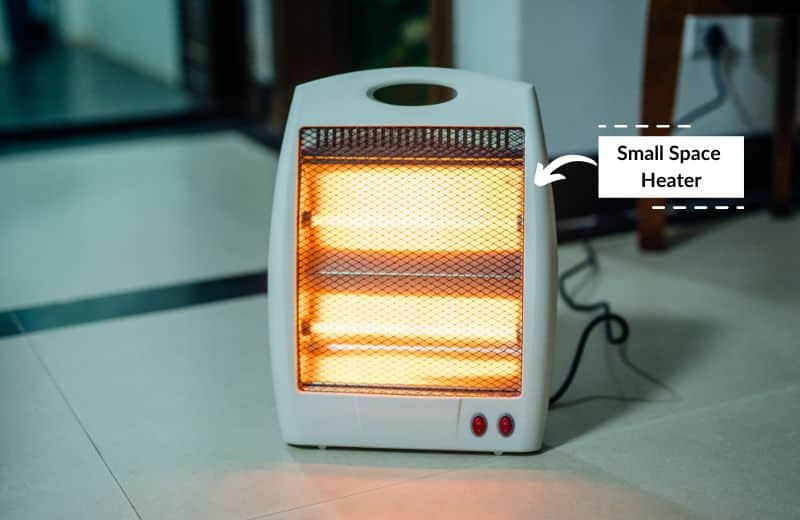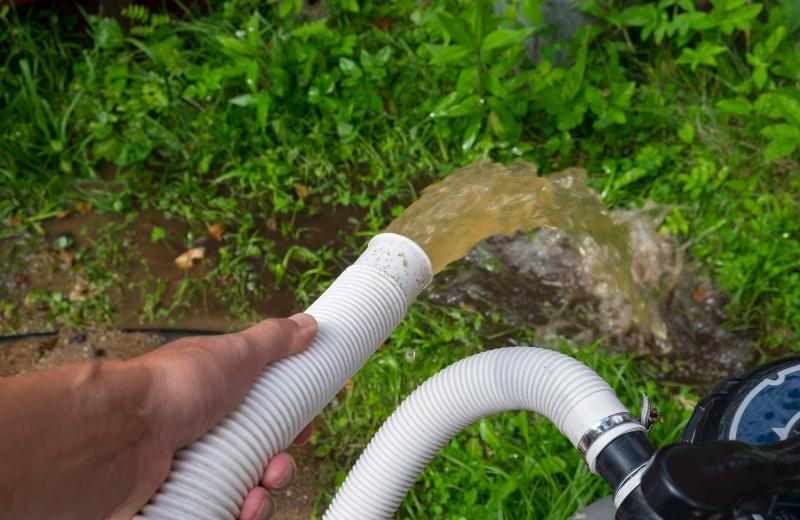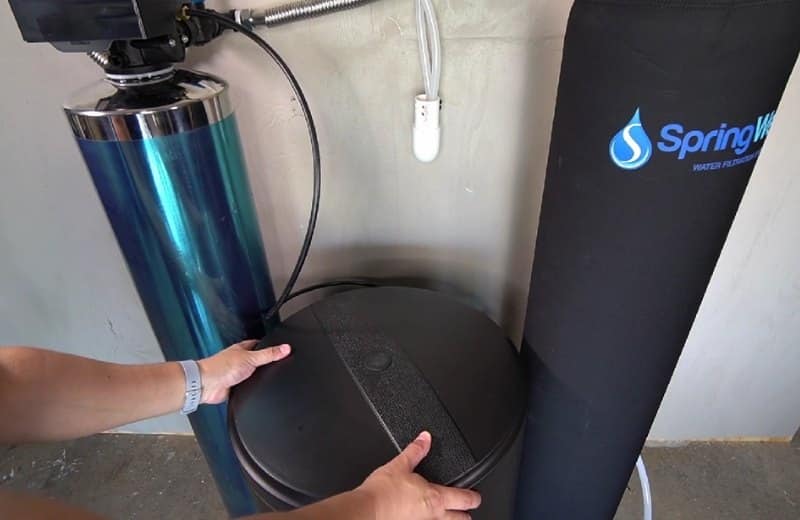Water softeners are often installed in locations that don’t have central heating, like basements, crawl spaces, garages, and sheltered outdoor spots.
A frozen water softener won’t work, so it’s important to winterize your water softener to stop it from being damaged by the cold weather.
In this guide, we’ve shared our top tips on how to prevent a water softener from freezing.
📌 Key Takeaways:
- Winterizing your water softener will prevent freezing.
- Freeing temperatures may stop water from flowing in the system and make it impossible for the unit to regenerate.
- You can keep your water softener from freezing by insulating the softener tank and pipes, using a space heater in the softener’s location, and keeping your water running.
- You may need to drain and disconnect your water softener if you plan to be away from home during the winter, or you won’t be using your softener over winter.
Table of Contents
❄️ How To Prevent A Water Softener From Freezing
Here are our top tips on how to prevent freezing in a water softener.
Insulate Your Softener Pipes And Tanks
The best way to prevent water softeners from freezing is by using protective insulation.
In regions with a milder climate that don’t have extended periods of extreme weather, simply insulating the tanks and pipes should do the job of preventing the softener from freezing in the colder months.
The media tank (resin tank) is most at risk of freezing. Some people build or buy an insulating box that’s installed around this tank, trapping the heat and preventing damage to the resin. You can easily make your own insulating box – just buy an insulated blanket or sheets of plumbing insulation, and use them to line a wooden box.
Some manufacturers sell insulating tank jackets that save you the effort of having to make your own insulating box.
Brine tanks are less likely to freeze because of their salt saturation, but they should still be insulated in regions with below-zero winters.
👨🔧 To insulate the pipes connecting your water softener system, buy pipe insulation wrap (available at most home improvement stores). You can also use electric pipe heating cables or heat tape for your water lines.

Bury The Softener Underground
In regions that don’t have extended cold periods, burying a water softener underground should be enough to prevent it from freezing.
The earth acts as natural insulation, helping to keep the softener from freezing. The added benefit is that you’re also protecting the softener from theft because a buried softener is much more difficult to steal.
Remember, the longer the period of cold, the deeper the earth will freeze. So if you live in a region with long, harsh winters, don’t take the risk – you’re best off installing an insulated box around the softener.
Use a Space Heater Near Your Softener Location
Another way to protect your water treatment equipment in an unheated indoor location is to use a small heater, like a space heater, near the softener.
You only need to prevent the temperature from dropping below 32 degrees Fahrenheit (0 degrees Celsius), so the water heater doesn’t need to be on a high heat, and it probably won’t need to be on all the time.
Still, if the extra energy bills don’t sound appealing, stick to an insulating box for your softener.

Keep Your Water Running
Finally, a simple short-term solution for water softener winterization is to open a faucet slightly to keep water flowing through the unit.
Standing water is much more likely to freeze than running water, so keeping your water running should offer adequate protection against freezing (at least enough to prevent freezing pipes and bursts) if you’re just away from home for a couple of days.
However, it’s not a 100% reliable solution, and leaving your water running – no matter how little – will inflate your water bill.
📆 When To Drain And Disconnect Your Water Softener
In some cases, simply winterizing your water softener with the above methods won’t suffice.
You might need to completely drain and disconnect your water softener if you don’t plan to use it over the winter months, or you’re going to be away for a long period when the temperature is likely to drop to below freezing.

📖 How To Drain & Disconnect A Water Softener
It’s recommended to drain the tanks of your softening system to prevent freezing water from damaging the resin and brine materials. This involves initiating a manual regeneration cycle, then waiting for the softener to send water down the drain.
To drain and disconnect the water treatment equipment in your softener, follow these steps:
- Set your softener to manually regenerate. You can do this by adjusting the programming on the softener’s control valve or control head.
- Wait until the softener flushes the system backwashing water from the resin tank down the drain. Allow all the water to flow through the drain pipe before moving on to the next step.
- Skip the rest of the regeneration steps on the control valve.
- Engage the water softener’s manual bypass valve to send the water supply around the water softener, isolating the softening unit from the rest of your home’s plumbing system. There should be a lever or a knob to turn to bypass position.
- Unplug the water softener. This will prevent the system from trying to regenerate while it’s not in use.
- Drain the remaining water by using a wet vac or siphon tubing, scooping the water out with a bucket, or using a hose bib, a water pump, or a drainage tap (if included).
- Scoop the standing water from the brine tank. You don’t have to remove all the water; the leftover solution shouldn’t freeze because it contains a lot of salt.
- Disconnect the drain line, the inlet pipe, and the outlet pipe.
- Remove the resin tank and the brine take and put them in a warm location that won’t freeze.
📌 Your user manual should have more information on exactly how to remove your water softener system from your plumbing. We’ve also shared a detailed guide on the process, which you can read here.

🤔 Why Is Winterizing Your Water Softener Important?
Water softeners usually have resin tanks made from fiberglass, which is durable, but not good at insulating against the cold. Some manufacturers sell neoprene covers to offer further insulation, but even these don’t provide complete protection against freezing conditions.
Insulating a water softener is, therefore, essential if you believe the softener’s media tank, brine tank, or pipes are at risk of freezing.
If you don’t winterize your water softener, or you don’t do a good enough job at winterizing the water softening equipment, here’s what might happen:
- The softener fails to produce soft water due to frozen resin damage or frozen water in the system
- You don’t get access to a soft water supply due to frozen pipes
- The softener can’t regenerate due to a frozen drain line or damaged resin
- The softener floods or leaks due to a blockage in a frozen pipe
❔ How To Keep A Water Softener From Freezing: FAQ
At what temperature will a water softener freeze?
A water softener is usually at risk of freezing if housed in temperatures below 32 degrees Fahrenheit (0 degrees Celsius) for more than 1 hour.
How do I winterize my outdoor water softener?
The best way to winterize your water softener outdoors is to install an insulated cabinet around the softener tanks and purchase pipe insulation wrap for outdoor pipes connecting to the system. This will prevent the softener from being damaged by extremely cold temperatures in harsh winters. You could also bury the softener underground, where it’ll be insulated by the surrounding earth.
Can a water softener tank freeze?
Yes, a water softener’s tank can freeze. A water softener in operation contains water. When the tank is subjected to freezing temperatures, the water inside the tank will freeze. Not only does this potentially damage the softening resin; it also increases the likelihood of leaks and pipe bursts.
Will a water softener drain line freeze?
Yes, the drain line in a water softener will freeze if it’s exposed to freezing temperatures. This increases the risk of serious leaks and flooding, as a frozen, blocked drain will prevent or reduce the flow of drain water during a regeneration cycle. Freezing temperatures may also cause the drain to rupture.

